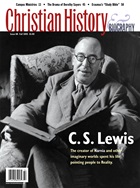In The Voyage of the Dawn Treader, one of the Narnia series, Eustace, a factual-minded, thoroughly modern boy, meets a fallen star named Ramandu. On hearing that Ramandu is a star, Eustace says, "In our world, a star is a huge ball of flaming gas." Ramandu replies, "Even in your world, my son, that is not what a star is but only what it is made of."
This distinction between scientia (knowledge, the makeup of things) and sapientia (wisdom, the significance of things) informed all of Lewis's writings, especially his fiction. Except for a brief period as an undergraduate when he tried to adopt modernist skepticism, Lewis spent his life pursuing wisdom. The pursuit led him to the philosophy of Plato and Wordsworth, but he also practiced the common sense Christianity of Samuel Johnson. Even though Lewis was a Platonist, he did not often talk of the visible world as a mere shadow of the real. In Letters to Malcolm, he says, "In fact we should never ask of anything 'Is it real?,' for everything is real." We may think of our world as a stage set, but it is a real stage set. Because he thought everything was real, Lewis could create imaginary worlds with gusto.
The good, the bad, and the ghostly
In his worlds, missing reality is the prime error. It happens in two ways: either to focus completely on facts and miss significance, or to become self-centered and miss the real beauty of creation. In Lewis's stories, the good people either possess or acquire the ability to touch reality, while the bad people are entangled in illusion. Like the inhabitants of Dante's hell, they lack the good of the intellect.
Lewis's fiction was based on his approach to reality from the beginning, but it became more profound as he followed his imagination. In The Pilgrim's Regress (1933), a satirical allegory dashed off in the heat of his adult acceptance of Christianity, the pilgrim John travels, confused, through the intellectual milieu of the early 1930s. But after he is baptized, he retraces his steps and sees the illusions of modernism. In The Great Divorce (1946), angels, saints, and the environment of heaven are real. They are so solid and heavy that the tourists from hell are mere ghosts in comparison, and the very grass hurts their feet. They are offered the chance to become real, but they prefer to cling to their whiny, self-centered illusions. In The Screwtape Letters (1942), Screwtape, a senior devil in the Lowerarchy of hell, writes to his nephew Wormwood, a field tempter, to teach him how to lead his client away from reality. But Wormwood's temptation efforts are ineffectual; his client dies in an air raid and meets "Them" [the angels] with joy and recognition.
To eternity and beyond
In 1938, Lewis began to publish his space trilogy. All three novels picture the solar system not in terms of what it is made of, but in terms of what it means—not cold, empty space, but golden warmth so full of angelic powers that the planets seem like relative emptiness. These novels show Lewis's growing desire to use popular fiction to turn his readers' hearts toward what is real. In Out of the Silent Planet, Ransom, the hero, says, "What we need for the moment is … a body of people familiarized with certain ideas."
By the time Lewis wrote Perelandra (1943) and That Hideous Strength (1945), he had realized that "certain ideas" were not as important as the training of feelings. In 1943 he delivered the Riddell Lectures, later published as The Abolition of Man. In it he explains that in literature and the other arts, the child must be guided to feel pleasure in works that are delightful and well made and to "hate the ugly" with "a just distaste." He must learn to "give delighted praise to beauty, receiving it into his soul and being nourished by it, so that he becomes a man of gentle heart."
Perelandra exemplifies the delighted praise of beauty in a hymn to creation, the praise of the great cosmic dance. This hymn worships the Creator with such plenitude that sometimes reading groups have divided it among different voices and recited it in a worship service. That Hideous Strength teaches the hatred of ugliness and evil by the actions of Frost and Wither. There is an Objective Room, where everything is subtly out of shape. Frost uses it to train neophytes to abandon their natural emotions in favor of (falsely) scientific objectivity. Mark receives this training, but he escapes from it and is healed by reading a children's story.
Through the wardrobe
After finishing the adult fantasies, Lewis turned to writing his best-known work, the Chronicles of Narnia. These stories take their place with The Wind in the Willows, The Velveteen Rabbit, and The Little Prince as childhood classics. They are exciting and skillfully told, but also theologically profound and deeply devotional. And therein arises a problem. It is easy to think that children should immediately identify Aslan with Jesus. Instead, they need to "freely receive" this beautiful art into their souls and be nourished by it.
Now that The Lion, the Witch, and the Wardrobe has been made into a movie, it is being touted as "The Passion of the Christ for Kids," and there are numerous websites explaining the cognitive doctrines of Christianity in language worthy of the grammarian Pulverulentus Siccus (Full-of-Dust Dry) in Prince Caspian. The allegorical correspondence between events in the stories and cognitive doctrines may be what the Chronicles are made of, but it is not what they are.
As Lewis explains in his essay "Sometimes Fairy Stories May Say Best What's to Be Said," at first he had no intention of promoting Christian ideas. He began to write The Lion, the Witch, and the Wardrobe because he had begun to see images: "a faun carrying an umbrella, a queen on a sledge, a magnificent lion." The fairy tale seemed the best literary form to handle the events that were growing from the images. Later on, he began to see how the stories could be used to get away from stained-glass boredom and cultivate Christian feelings, especially among children who were alienated from Sunday school. To teach the Chronicles as Christian doctrine is to defeat Lewis's purpose in writing. Similarly, to demand that the reader respond with the "delighted praise of beauty" is to foster the literary snobbery that Lewis hated.
Trying to enjoy the Chronicles is self-defeating, like trying to fall asleep. The only way to succeed is not to try. A child who likes fantasy (not all children do) will benefit from the Chronicles naturally. An adult who likes fantasy can get the greatest value from them by reading them to a child—without comment unless the child asks questions. Lacking a suitable child, the next-best course for the adult is to read the Chronicles on vacation.
The Lion, the Witch, and the Wardrobe is especially beautiful in its portrayal of the children's relationship to Aslan. Lewis provides images that feel like the Christian's exchange of love with Jesus. It is like hugging and being hugged in lush fur, like being tossed in the air and caught by velvet paws, like riding on a swift animal as big as a horse but smooth-gaited as a cat, like being called "dear heart" and "my son." Aslan breathes on the children to give them courage; he roars when the White Witch suggests that he might not keep his word, for he is fearsome as well as loving. He goes meekly to meet his death; he is mocked and tortured. Lucy and Susan weep bitterly; so do adults and sophisticated junior high students.
How did a middle-aged bachelor come to write The Lion, the Witch, and the Wardrobe? He did it by writing the book he would like to read himself. He treated children like people, patiently and respectfully answering their questions. And he took very seriously what Jesus said about entering the kingdom of heaven as a little child.
Something better
After the Chronicles, Lewis wrote his adult masterpiece in the training of feelings, Till We Have Faces. He called it "far and away the best I have written," but then added ruefully, "That book … has been my one big failure both with the critics and with the public." Fifty years later, it is still Lewis's best book, but also the one least known by the public. Like its heroine Orual, it is both stepchild and princess. Some people have never tried to read it, but a few others read it over and over.
The Chronicles of Narnia educate the feelings through pleasure, as befits fiction for children. Till We Have Faces asks us to follow a woman who has had a miserable life, partly because she felt unjustly treated by God, but mostly because her self-centeredness rendered her unable to perceive reality. It is a very complex, subtle picture of the human spiritual journey, and those who are humble enough to perceive their own faults in Orual can find catharsis and repentance in it. By feeling compassion for Orual, we may learn to accept Christ's compassion for us.
There is a lot of Orual in Lewis, but his imagination, combined with his feelings for beauty and the real, gave him hope. In Letters to Malcolm, published posthumously, he imagined what heaven would be like, then concluded, "Guesses, of course, only guesses. If they are not true, something better will be."
Doris T. Myers is the author of two books on Lewis's fiction, C. S. Lewis in Context (Kent State Univ. Press, 1994) and Bareface: A Guide to C. S. Lewis's Last Novel (Univ. of Missouri Press, 2004).
Copyright © by the author or Christianity Today/Christian History & Biography magazine.
Click here for reprint information on Christian History & Biography.

Support Our Work
Subscribe to CT for less than $4.25/month






























